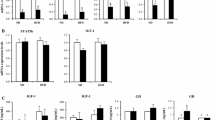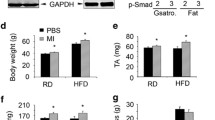Abstract
Hepatocyte growth factor (HGF) is a cytokine that increases glucose transport ex vivo in skeletal muscle. The aim of this work was to decipher the impact of whether conditional overexpression of HGF in vivo could improve glucose homeostasis and insulin sensitivity in mouse skeletal muscle. Following tetracyclin administration, muscle HGF levels were augmented threefold in transgenic mice (SK-HGF) compared to control mice without altering plasma HGF levels. In conditions of normal diet, SK-HGF mice showed no differences in body weight, plasma triglycerides, blood glucose, plasma insulin and glucose tolerance compared to control mice. Importantly, obese SK-HGF mice exhibited improved whole-body glucose tolerance independently of changes in body weight or plasma triglyceride levels compared to control mice. This effect on glucose homeostasis was associated with significantly higher (∼80 %) levels of phosphorylated protein kinase B in muscles from SK-HGF mice compared to control mice. In conclusion, muscle expression of HGF counteracts obesity-mediated muscle insulin resistance and improves glucose tolerance in mice.




Similar content being viewed by others
Abbreviations
- DOX:
-
Doxycycline
- GADPH:
-
Glyceraldehyde 3-phosphate dehydrogenase
- HGF:
-
Hepatocyte growth factor
- IPGTT:
-
Intraperitoneal glucose tolerance test
- IPITT:
-
Intraperitoneal insulin tolerance test
- mHGF:
-
Mouse HGF
- MCK:
-
Muscle creatine kinase promoter
- (PI3K):
-
Phosphatidylinositol 3-kinase
- rtTA:
-
Reverse tetracycline Transactivator
References
Araujo TG, Oliveira AG, Carvalho BM, Guadagnini D, Protzek AO, Carvalheira JB, Boschero AC, Saad MJ (2012) Hepatocyte growth factor plays a key role in insulin resistance-associated compensatory mechanisms. Endocrinology 153:5760–5769
Bell LN, Ward JL, Degawa-Yamauchi M, Bovenkerk JE, Jones R, Cacucci BM, Gupta CE, Sheridan C, Sheridan K, Shankar SS, Steinberg HO, March KL, Considine RV (2006) Adipose tissue production of hepatocyte growth factor contributes to elevated serum HGF in obesity. Am J Physiol Endocrinol Metab 291:E843–E848
Bertola A, Bonnafous S, Cormont M, Anty R, Tanti JF, Tran A, Le Marchand-Brustel Y, Gual P (2007) Hepatocyte growth factor induces glucose uptake in 3T3-L1 adipocytes through A Gab1/phosphatidylinositol 3-kinase/Glut4 pathway. J Biol Chem 282:10325–10332
Bottaro DP, Rubin JS, Faletto DL, Chan AM, Kmiecik TE, Vande Woude GF, Aaronson SA (1991) Identification of the hepatocyte growth factor receptor as the c-met proto-oncogene product. Science 251:802–804
de Courten B, de Courten MP, Dougherty S, Forbes JM, Potts JR, Considine RV (2013) Insulin infusion reduces hepatocyte growth factor in lean humans. Metabolism 62:647–650
Fafalios A, Ma J, Tan X, Stoops J, Luo J, Defrances MC, Zarnegar R (2011) A hepatocyte growth factor receptor (Met)-insulin receptor hybrid governs hepatic glucose metabolism. Nat Med 17:1577–1584
Fiaschi-Taesch NM, Santos S, Reddy V, Van Why SK, Philbrick WF, Ortega A, Esbrit P, Orloff JJ, Garcia-Ocana A (2004) Prevention of acute ischemic renal failure by targeted delivery of growth factors to the proximal tubule in transgenic mice: the efficacy of parathyroid hormone-related protein and hepatocyte growth factor. J Am Soc Nephrol 15:112–125
Field AE, Coakley EH, Must A, Spadano JL, Laird N, Dietz WH, Rimm E, Colditz GA (2001) Impact of overweight on the risk of developing common chronic diseases during a 10-year period. Arch Intern Med 161:1581–1586
Formiguera X, Canton A (2004) Obesity: epidemiology and clinical aspects. Best Pract Res Clin Gastroenterol 18:1125–1146
Ghersa P, Gobert RP, Sattonnet-Roche P, Richards CA, Merlo Pich E, Hooft van Huijsduijnen R (1998) Highly controlled gene expression using combinations of a tissue-specific promoter, recombinant adenovirus and a tetracycline-regulatable transcription factor. Gene Ther 5:1213–1220
Grill MA, Bales MA, Fought AN, Rosburg KC, Munger SJ, Antin PB (2003) Tetracycline-inducible system for regulation of skeletal muscle-specific gene expression in transgenic mice. Transgenic Res 12:33–43
Hotamisligil GS (2006) Inflammation and metabolic disorders. Nature 444:860–867
Jimenez-Palomares M, Ramos-Rodriguez JJ, Lopez-Acosta JF, Pacheco-Herrero M, Lechuga-Sancho AM, Perdomo G, Garcia-Alloza M, Cozar-Castellano I (2012) Increased Abeta production prompts the onset of glucose intolerance and insulin resistance. Am J Physiol Endocrinol Metab 302:E1373–E1380
Kataoka H, Miyata S, Uchinokura S, Itoh H (2003) Roles of hepatocyte growth factor (HGF) activator and HGF activator inhibitor in the pericellular activation of HGF/scatter factor. Cancer Metastasis Rev 22:223–236
Kato Y, Yu D, Schwartz MZ (1998) Hepatocyte growth factor up-regulates SGLT1 and GLUT5 gene expression after massive small bowel resection. J Pediatr Surg 33:13–15
Liu Y, Sweeney G (2014) Adiponectin action in skeletal muscle. Best Pract Res Clin Endocrinol Metab 28:33–41
Lumeng CN, Saltiel AR (2011) Inflammatory links between obesity and metabolic disease. J Clin Invest 121:2111–2117
Nakamura T, Nawa K, Ichihara A (1984) Partial purification and characterization of hepatocyte growth factor from serum of hepatectomized rats. Biochem Biophys Res Commun 122:1450–1459
Perdomo G, Martinez-Brocca MA, Bhatt BA, Brown NF, O’Doherty RM, Garcia-Ocana A (2008) Hepatocyte growth factor is a novel stimulator of glucose uptake and metabolism in skeletal muscle cells. J Biol Chem 283:13700–13706
Rehman J, Considine RV, Bovenkerk JE, Li J, Slavens CA, Jones RM, March KL (2003) Obesity is associated with increased levels of circulating hepatocyte growth factor. J Am Coll Cardiol 41:1408–1413
Roccisana J, Reddy V, Vasavada RC, Gonzalez-Pertusa JA, Magnuson MA, Garcia-Ocana A (2005) Targeted inactivation of hepatocyte growth factor receptor c-met in beta-cells leads to defective insulin secretion and GLUT-2 downregulation without alteration of beta-cell mass. Diabetes 54:2090–2102
Stuart KA, Riordan SM, Lidder S, Crostella L, Williams R, Skouteris GG (2000) Hepatocyte growth factor/scatter factor-induced intracellular signalling. Int J Exp Pathol 81:17–30
Sun K, Kusminski CM, Scherer PE (2011) Adipose tissue remodeling and obesity. J Clin Invest 121:2094–2101
Swierczynski J, Korczynska J, Goyke E, Adrych K, Raczynska S, Sledzinski Z (2005) Serum hepatocyte growth factor concentration in obese women decreases after vertical banded gastroplasty. Obes Surg 15:803–808
Tatsumi R, Liu X, Pulido A, Morales M, Sakata T, Dial S, Hattori A, Ikeuchi Y, Allen RE (2006) Satellite cell activation in stretched skeletal muscle and the role of nitric oxide and hepatocyte growth factor. Am J Physiol Cell Physiol 290:C1487–C1494
Tsukagawa E, Adachi H, Hirai Y, Enomoto M, Fukami A, Ogata K, Kasahara A, Yokoi K, Imaizumi T (2013) Independent association of elevated serum hepatocyte growth factor levels with development of insulin resistance in a 10-year prospective study. Clin Endocrinol (Oxf) 79:43–48
Visiedo F, Bugatto F, Carrasco-Fernandez C, Saez-Benito A, Mateos RM, Cozar-Castellano I, Bartha JL, Perdomo G (2015) Hepatocyte growth factor is elevated in amniotic fluid from obese women and regulates placental glucose and fatty acid metabolism. Placenta 36:381–388
Visscher TL, Seidell JC (2001) The public health impact of obesity. Annu Rev Public Health 22:355–375
Wei Y, Chen K, Whaley-Connell AT, Stump CS, Ibdah JA, Sowers JR (2008) Skeletal muscle insulin resistance: role of inflammatory cytokines and reactive oxygen species. Am J Physiol Regul Integr Comp Physiol 294:R673–R680
Yamada M, Tatsumi R, Kikuiri T, Okamoto S, Nonoshita S, Mizunoya W, Ikeuchi Y, Shimokawa H, Sunagawa K, Allen RE (2006) Matrix metalloproteinases are involved in mechanical stretch-induced activation of skeletal muscle satellite cells. Muscle Nerve 34:313–319
Yuasa T, Kakuhata R, Kishi K, Obata T, Shinohara Y, Bando Y, Izumi K, Kajiura F, Matsumoto M, Ebina Y (2004) Platelet-derived growth factor stimulates glucose transport in skeletal muscles of transgenic mice specifically expressing platelet-derived growth factor receptor in the muscle, but it does not affect blood glucose levels. Diabetes 53:2776–2786
Acknowledgments
This study was supported by a grant from ISCIII (CP08/00106), MINECO (SAF2009-11282) and FP7-PEOPLE-2009-RG (PIRG06-GA-2009-25369) to GP; a grant from MINECO (RYC-2011-08101) to IC; and grants from the NIH R-01 (DK067351 and DK077096) to AGO.
Author information
Authors and Affiliations
Corresponding authors
Ethics declarations
Experimental procedures were approved by the Animal Care and Use Committee of the University of Cadiz (UCA) in accordance with the European Guidelines for Care and Use of Mammals in Research.
Rights and permissions
About this article
Cite this article
Sanchez-Encinales, V., Cozar-Castellano, I., Garcia-Ocaña, A. et al. Targeted delivery of HGF to the skeletal muscle improves glucose homeostasis in diet-induced obese mice. J Physiol Biochem 71, 795–805 (2015). https://doi.org/10.1007/s13105-015-0444-6
Received:
Accepted:
Published:
Issue Date:
DOI: https://doi.org/10.1007/s13105-015-0444-6




